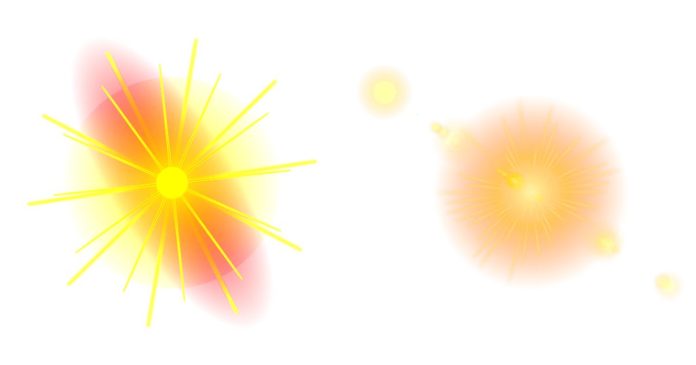Sunspots vs. Solar Flares: Understanding the Key Differences
When studying the Sun, two phenomena that often come up are sunspots and solar flares. While both are related to solar activity, they are very different in terms of their nature, formation, and effects. Here’s a breakdown of the key differences between these two:
1. What They Are
- Sunspots:
Sunspots are temporary, dark areas on the Sun’s surface (the photosphere) caused by intense magnetic activity. These spots appear darker than the surrounding areas because they are cooler, with temperatures about 3,000–4,000°C, compared to the Sun’s surface temperature of around 5,500°C. Sunspots are a natural part of the Sun’s 11-year solar cycle, and their number fluctuates during this period. - Solar Flares:
Solar flares are sudden, intense bursts of energy and radiation from the Sun’s surface and its atmosphere. These eruptions occur when the Sun’s magnetic fields suddenly realign or “reconnect,” releasing vast amounts of energy in the form of radiation (light, X-rays, gamma rays) and charged particles (such as electrons, protons, and heavy ions).
2. Formation and Cause
- Sunspots:
Sunspots form due to the Sun’s magnetic field. When magnetic fields are twisted and tangled, they can create areas of intense magnetic pressure that suppress the Sun’s normal convection process. This results in the cooler, darker spots on the Sun’s surface. - Solar Flares:
Solar flares occur when the Sun’s magnetic fields near sunspots become unstable. This instability causes a sudden release of energy in the form of a flare. The event usually involves magnetic reconnection, where oppositely charged magnetic fields merge and release energy. This can trigger a sudden burst of radiation and particles into space.
3. Duration
- Sunspots:
Sunspots are long-lived and can persist for days to weeks, or sometimes even months, depending on their size and the stage of the solar cycle. They are more prominent during the solar maximum when solar activity is at its peak. - Solar Flares:
Solar flares are short-lived events, typically lasting from minutes to hours. However, the radiation and particles from the flare can have lingering effects on the Earth’s atmosphere and magnetosphere long after the flare has subsided.
4. Effects and Impact
- Sunspots:
Sunspots themselves don’t directly affect Earth in a significant way, but they are linked to increased solar activity, such as solar flares and coronal mass ejections (CMEs), which can impact space weather. A large number of sunspots can indicate an active Sun, which could lead to more frequent solar storms that affect satellite communications, GPS systems, and even power grids. - Solar Flares:
Solar flares have more immediate and direct effects on Earth. The burst of radiation can disrupt radio communication, especially in high-frequency bands, and affect GPS signals, satellite operations, and even airline flights at high altitudes. Flare activity can also cause auroras (Northern and Southern Lights) as charged particles interact with Earth’s magnetic field. In extreme cases, strong solar flares can cause damage to electrical infrastructure and communication systems.
5. Visual Appearance
- Sunspots:
Sunspots appear as dark, circular spots on the Sun’s surface when viewed through specialized solar telescopes. The spots can range in size from a few kilometers to several times the size of Earth. They are surrounded by a lighter region known as the penumbra, where the magnetic activity is still strong but less intense than in the core of the sunspot (called the umbra). - Solar Flares:
Solar flares are not visible as “spots” on the Sun’s surface, but they are visible through various forms of radiation, such as X-rays and ultraviolet light. They often appear as bright bursts of light or eruptions emanating from sunspot regions. These flares can be observed by special instruments, such as solar telescopes or satellites that capture X-ray or ultraviolet emissions.
6. Relation to Solar Cycle
- Sunspots:
The number of sunspots follows an 11-year solar cycle, with the number of sunspots peaking during solar maximum and reaching a minimum during solar minimum. During solar maximum, the Sun is at its most active, and more sunspots are visible. - Solar Flares:
Solar flares are also more common during periods of solar maximum, when sunspot activity is at its peak. However, flares can happen at any point in the solar cycle, and their occurrence is often linked to sunspot activity. Stronger flares tend to occur when sunspots are larger and more numerous.
7. Energy Emission
- Sunspots:
Sunspots themselves don’t release significant amounts of energy. However, they are often associated with intense magnetic activity, which can trigger solar flares and coronal mass ejections (CMEs), which are massive bursts of solar wind and magnetic fields that can reach Earth. - Solar Flares:
Solar flares are extremely energetic events, releasing energy equivalent to billions of atomic bombs. They emit energy across the entire electromagnetic spectrum, from radio waves to gamma rays. This makes them much more energetic compared to sunspots.
8. Frequency
- Sunspots:
Sunspots occur regularly in cycles. There is typically a rise and fall in their number over the course of the 11-year solar cycle. However, the Sun can also go through periods of inactivity, such as the Maunder Minimum during the 17th century when sunspots were almost absent. - Solar Flares:
Solar flares happen much less frequently than sunspots, but during periods of high solar activity (solar maximum), the frequency of solar flares increases. A single solar flare can have a significant impact, but it is less common to experience multiple flares within a short period.
Related posts:
- What does ringing in the ears mean spiritually?
- What Colors Do Blue and Green Make?
- How Long Does Raw Chicken Really Last in the Fridge?
- What are some amazing and memorable Valentine’s Day ideas that will leave a lasting impression?
- What is the definition of ‘friends with benefits?
- What is the difference between a bachelor’s and a degree?


